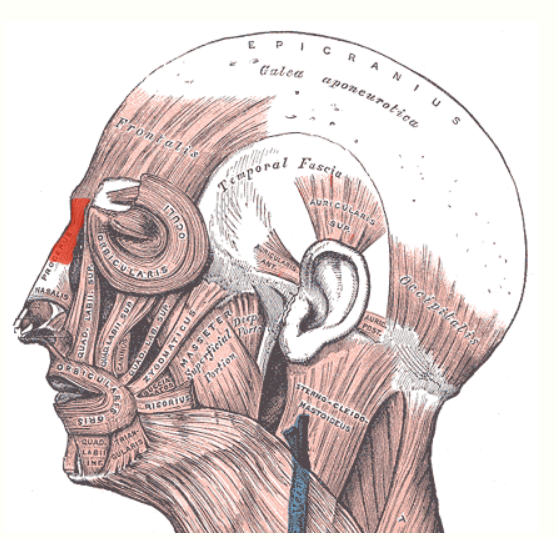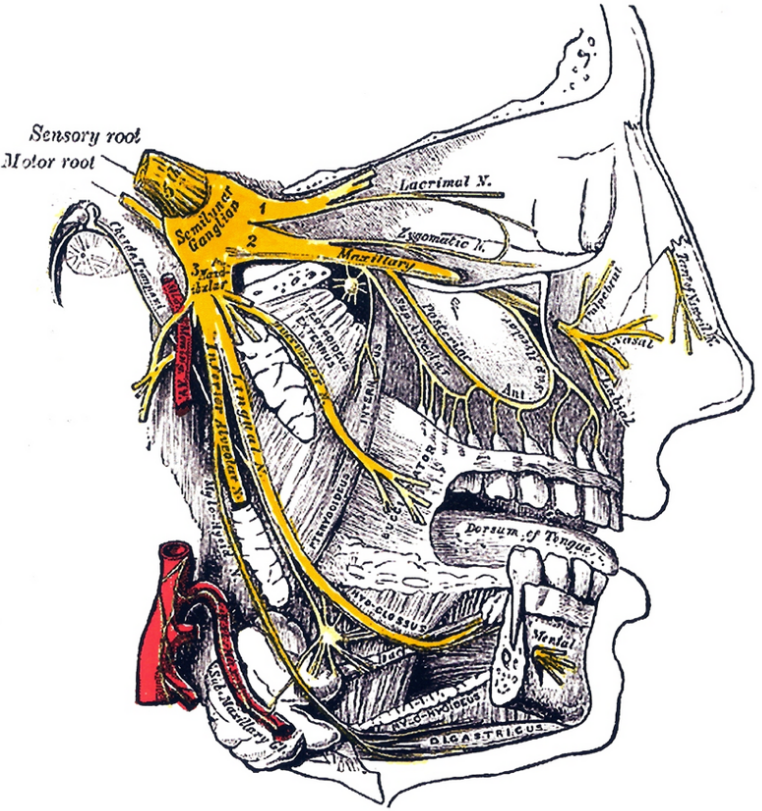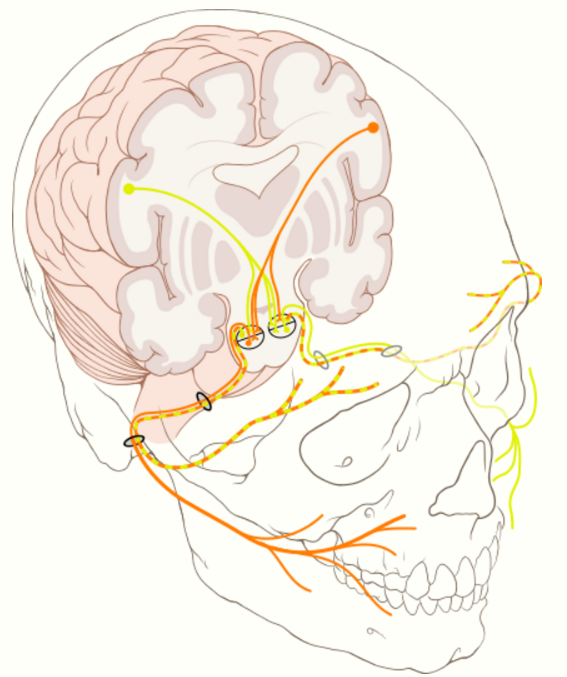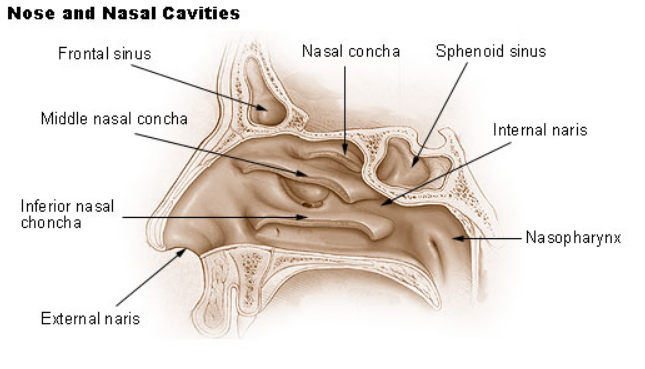The visible part of the human nose is the protruding part of the face that bears the nostrils. The shape of the nose is determined by the ethmoid bone and the nasal septum, which consists mostly of cartilage and which separates the nostrils. On average the nose of a male is larger than that of a female. The nasal root is the top of the nose, forming an indentation at the suture where the nasal bones meet the nasal part of the frontal bone. The anterior nasal spine is the thin projection of bone at the midline on the lower nasal margin, holding the cartilaginous center of the nose. Adult humans have nasal hair in the nostrils.
- nasal hair
- cartilage
- nasal bones
1. Structure

1.1. Bony Anatomy
Paired nasal bones in the upper part of the nose attach to the nasal part of the frontal bone, forming the bridge of the nose. Above and to the side (superolaterally), the paired nasal bones connect to the lacrimal bones, and below and to the side (inferolaterally), they attach to the frontal processes of the maxilla (upper jaw). Above and to the back (posterosuperiorly), the bony nasal septum is composed of the perpendicular plate of the ethmoid bone, and the lower vomer bone that lies below and to the back (posteroinferiorly), and partially forms the choanal opening into the nasopharynx, that is continuous with the nasal cavity. The floor of the nose comprises the incisive bone and the palatine bone, the roof of the mouth.
The bony part of the nasal septum is composed of the vomer bone (the lower part of the nasal septum), the perpendicular plate, (the upper part of the septum), aspects of the premaxilla, and the palatine bones. Each lateral nasal wall contains three nasal conchae, (also called turbinates) which are small, thin, shell-form bones: (i) the superior concha, (ii) the middle concha, and (iii) the inferior concha. Lateral to the conchae is the medial wall of the maxillary sinus. Inferior to each nasal concha is a nasal meatus, with names that correspond to the conchae, as superior meatus, middle meatus and inferior meatus. The internal roof of the nose is composed by the horizontal, perforated cribriform plate (of the ethmoid bone) through which pass sensory fibers of the olfactory nerve (CN1); finally, below and behind (posteroinferior) the cribriform plate, sloping down at an angle, is the bony face of the sphenoidal sinus.
1.2. Cartilaginous Anatomy
Several nasal cartilages make up the cartilaginous part of the nasal framework. The septal nasal cartilage, extends from the nasal bones in the midline (above) to the bony septum in the midline (posteriorly), then down along the bony floor. The septum is quadrangular; the upper half is flanked by two (2) triangular-to-trapezoidal lateral nasal cartilages which are fused to the dorsal septum in the midline, and laterally attached, with loose ligaments, to the bony margin of the pyriform (pear-shaped) aperture, while the inferior ends of the lateral cartilages are free (unattached). The internal area (angle), formed by the septum and upper lateral cartilage, constitutes the internal valve of the nose; the accessory nasal cartilages are adjacent to the lateral cartilages in the fibroareolar connective tissue. The respective external valve of each nose is variably dependent upon the size, shape, and strength of the lower greater alar cartilage.[1]
Beneath the lateral cartilages lay the greater alar cartilages, which swing outwards, from medial attachments, to the caudal septum in the midline (the medial crura) to an intermediate crus (shank) area. Finally, the greater alar cartilages flare outwards, above and to the side (superolaterally), as the lateral crura; these cartilages are mobile, unlike the upper lateral cartilages. Furthermore, some persons present anatomical evidence of nasal scrolling—i.e. an outward curving of the lower borders of the upper lateral-cartilages, and an inward curving of the cephalic borders of the alar cartilages.
Soft tissue
- Nasal skin – Like the underlying bone-and-cartilage (osseo-cartilaginous) support framework of the nose, the external skin is divided into vertical thirds (anatomic sections); from the glabella (the space between the eyebrows), to the bridge, to the tip, for corrective plastic surgery, the nasal skin is anatomically considered, as the:
- Upper third section – the skin of the upper nose is thick, and relatively distensible (flexible and mobile), but then tapers, adhering tightly to the osseo-cartilaginous framework, and becomes the thinner skin of the dorsal section, the bridge of the nose.
- Middle third section – the skin overlying the bridge of the nose (mid-dorsal section) is the thinnest, least distensible, nasal skin, because it most adheres to the support framework.
- Lower third section – the skin of the lower nose is as thick as the skin of the upper nose, because it has more sebaceous glands, especially at the nasal tip.
- Nasal lining – At the vestibule, the human nose is lined with a mucous membrane of squamous epithelium, which tissue then transitions to become columnar respiratory epithelium, a pseudo-stratified, ciliated (lash-like) tissue with abundant seromucinous glands, which maintains the nasal moisture and protects the respiratory tract from bacteriologic infection and foreign objects.
- Nasal muscles – The movements of the human nose are controlled by groups of facial and neck muscles that are set deep to the skin; they are in four (4) functional groups that are interconnected by the nasal superficial aponeurosis—the superficial musculoaponeurotic system (SMAS)—which is a sheet of dense, fibrous, collagenous connective tissue that covers, invests, and forms the terminations of the muscles.
- the elevator muscle group includes the procerus muscle and the levator labii superioris alaeque nasi muscle.
- the depressor muscle group includes the alar nasalis muscle and the depressor septi nasi muscle.
- the compressor muscle group includes the transverse nasalis muscle.
- the dilator muscle group includes the dilator naris muscle that expands the nostrils; it is in two parts: (i) the dilator nasi anterior muscle, and (ii) the dilator nasi posterior muscle.
Blood supply and drainage
Like the face, the human nose is well vascularized with arteries and veins, and thus supplied with abundant blood. The principal arterial blood-vessel supply to the nose is two-fold: (i) branches from the internal carotid artery, the branch of the anterior ethmoid artery, the branch of the posterior ethmoid artery, which derive from the ophthalmic artery; (ii) branches from the external carotid artery, the sphenopalatine artery, the greater palatine artery, the superior labial artery, and the angular artery.
The external nose is supplied with blood by the facial artery, which becomes the angular artery that courses over the superomedial aspect of the nose. The sellar region of the sella turcica, and the dorsal region of the nose are supplied with blood by branches of the internal maxillary artery (infraorbital) and the ophthalmic arteries that derive from the internal common carotid artery system.
Internally, the lateral nasal wall is supplied with blood by the sphenopalatine artery (from behind and below) and by the anterior ethmoid artery and the posterior ethmoid artery (from above and behind). The nasal septum also is supplied with blood by the sphenopalatine artery, and by the anterior and posterior ethmoid arteries, with the additional circulatory contributions of the superior labial artery and of the greater palatine artery. These three (3) vascular supplies to the internal nose converge in the Kiesselbach's plexus, which is a region in the anteroinferior-third of the nasal septum, (in front and below). Furthermore, the nasal vein vascularisation of the nose generally follows the arterial pattern of nasal vascularisation. The nasal veins are biologically significant, because they have no vessel-valves, and because of their direct, circulatory communication to the sinus caverns, which makes possible the potential intracranial spreading of a bacterial infection of the nose. Because of such an abundant nasal blood supply, tobacco smoking compromises post-operative healing.
Lymphatic drainage
The pertinent nasal lymphatic system arises from the superficial mucosa, and drains posteriorly to the retropharyngeal nodes (in back), and anteriorly (in front), either to the upper deep cervical nodes (in the neck), or to the submandibular glands (in the lower jaw), or into both the nodes and the glands of the neck and the jaw.
Innervation

The sensations registered by the human nose derive from the first two branches of the trigeminal nerve (cranial nerve V). The nerve listings indicate the respective innervation (sensory distribution) of the trigeminal nerve branches within the nose, the face, and the upper jaw (maxilla).

- Lacrimal nerve – conveys sensation to the skin areas of the lateral orbital (eye socket) region, except for the lacrimal gland.
- Frontal nerve – conveys sensation to the skin areas of the forehead and the scalp.
- Supraorbital nerve – conveys sensation to the skin areas of the eyelids, the forehead, and the scalp.
- Supratrochlear nerve – conveys sensation to the medial region of the eyelid skin area, and the medial region of the forehead skin.
- Nasociliary nerve – conveys sensation to the skin area of the nose, and the mucous membrane of the anterior (front) nasal cavity.
- Anterior ethmoid nerve – conveys sensation in the anterior (front) half of the nasal cavity: (a) the internal areas of the ethmoid sinus and the frontal sinus; and (b) the external areas, from the nasal tip to the rhinion: the anterior tip of the terminal end of the nasal-bone suture.
- Posterior ethmoid nerve – serves the superior (upper) half of the nasal cavity, the sphenoids, and the ethmoids.
- Intratrochlear nerve – conveys sensation to the medial region of the eyelids, the palpebral conjunctiva, the nasion (nasolabial junction), and the bony dorsum.
- The maxillary division innervation
Maxillary nerve – conveys sensation to the upper jaw and the face.
- Infraorbital nerve – conveys sensation to the area from below the eye socket to the external nares (nostrils).
- Zygomatic nerve – through the zygomatic bone and the zygomatic arch, conveys sensation to the cheekbone areas.
- Superior posterior dental nerve – sensation in the teeth and the gums.
- Superior anterior dental nerve – mediates the sneeze reflex.
- Sphenopalatine nerve – divides into the lateral branch and the septal branch, and conveys sensation from the rear and the central regions of the nasal cavity.


The supply of parasympathetic nerves to the face and the upper jaw (maxilla) derives from the greater superficial petrosal (GSP) branch of cranial nerve VII, the facial nerve. The GSP nerve joins the deep petrosal nerve (of the sympathetic nervous system), derived from the carotid plexus, to form the vidian nerve (in the vidian canal) that traverses the pterygopalatine ganglion (an autonomic ganglion of the maxillary nerve), wherein only the parasympathetic nerves form synapses, which serve the lacrimal gland and the glands of the nose and of the palate, via the (upper jaw) maxillary division of cranial nerve V, the trigeminal nerve.
1.3. Internal Nasal Anatomy
In the midline of the nose, the septum is a composite (bony-cartilaginous) structure that divides the nose into two similar halves. The lateral nasal wall and the paranasal sinuses, the superior concha, the middle concha, and the inferior concha, form the corresponding passages, the superior meatus, the middle meatus, and the inferior meatus, on the lateral nasal wall. The superior meatus is the drainage area for the posterior ethmoid bone cells and the sphenoid sinus; the middle meatus provides drainage for the anterior ethmoid sinuses and for the maxillary and frontal sinuses; and the inferior meatus provides drainage for the nasolacrimal duct.
The internal nasal valve comprises the area bounded by the upper lateral-cartilage, the septum, the nasal floor, and the anterior head of the inferior turbinate. In the narrow (leptorrhine) nose, this is the narrowest portion of the nasal airway. Generally, this area requires an angle greater than 15 degrees for unobstructed breathing; for the correction of such narrowness, the width of the nasal valve can be increased with spreader grafts and flaring sutures.
The content is sourced from: https://handwiki.org/wiki/Medicine:Anatomy_of_the_human_nose
References
- "Anthropometric measurements of the external nose in 18–25-year-old Sistani and Baluch aborigine women in the southeast of Iran". Folia Morphol. (Warsz) 68 (2): 88–92. May 2009. PMID 19449295. http://www.ncbi.nlm.nih.gov/pubmed/19449295
